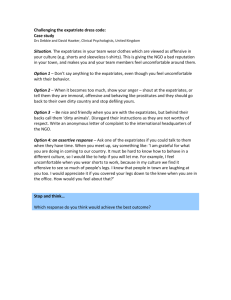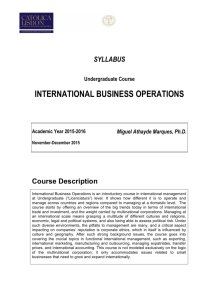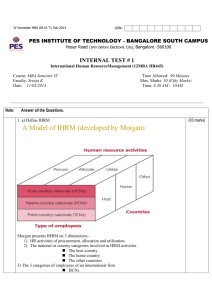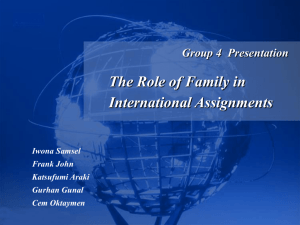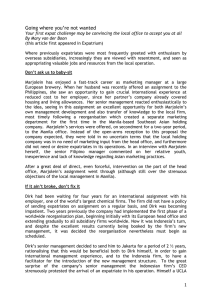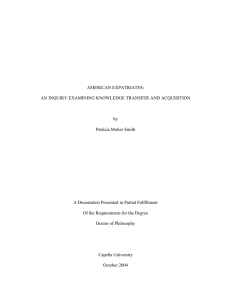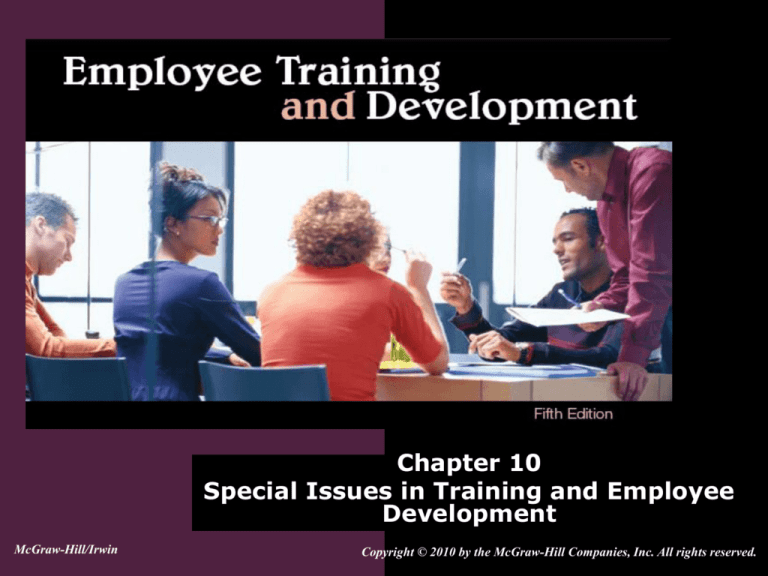
Chapter 10
Special Issues in Training and Employee
Development
McGraw-Hill/Irwin
Copyright © 2010 by the McGraw-Hill Companies, Inc. All rights reserved.
Table 10.1 - Situations That may
Result in Legal Action
8-2
Training Issues Resulting From
the External Environment
Cross-cultural preparation - involves
educating employees (expatriates) and
their families who are to be sent to a
foreign country.
Expatriates - people who work in a country
other than their country of origin.
8-3
Table 10.2 - Types of Employees
in Global Companies
8-4
Training Issues Resulting From
the External Environment (cont.)
G. Hofstede identified five dimensions of
national culture:
Individualism-collectivism
Uncertainty avoidance
Masculinity-femininity
Power distance
Time orientation
8-5
Training Issues Resulting From
the External Environment (cont.)
To be successful in overseas assignments,
expatriates need to be:
Competent in their area of expertise.
Able to communicate verbally and nonverbally
in the host country.
Flexible, tolerant of ambiguity, emotionally
stable, outgoing and agreeable, and sensitive
to cultural differences.
8-6
Training Issues Resulting From
the External Environment (cont.)
To be successful in overseas assignments,
expatriates need to be:
Motivated to succeed, able to enjoy the
challenge of working in other countries, and
willing to learn about the host country’s
culture, language, and customs.
Supported by their families.
8-7
Training Issues Resulting From
the External Environment (cont.)
Key to successful foreign assignment is a
combination of training and career
management for employees and their
families.
Foreign assignments involve three
phases:
Pre-departure phase
On-site phase
Repatriation phase
8-8
Training Issues Resulting From
the External Environment (cont.)
Pre-departure phase
Employees need to receive language training
and an orientation in the new country’s
culture and customs; the family should be
included in the orientation.
Expatriates and their families need
information about the various facilities in the
area where they will live.
Employees must discuss with their managers
how the foreign assignment fits into their
career plans and what type of position they
can expect upon return.
8-9
Figure 10.2 - Relationship Between
Training Methods and Training Rigor
8-10
Training Issues Resulting From
the External Environment (cont.)
On-site phase
Training involves continued orientation to the
host country and its customs and cultures
through formal programs or through a
mentoring relationship.
Expatriates and their families may be paired
with a mentor from the host country who
helps them understand the new, unfamiliar
work environment and community.
8-11
Training Issues Resulting From
the External Environment (cont.)
Repatriation phase
Prepares expatriates for return to the parent
company and country from the foreign
assignment.
Expatriates and their families are likely to
experience high levels of stress and anxiety
when they return because of the changes that
have occurred since their departure.
Expatriates decide to leave the company
because the assignment they are given upon
return has less responsibility, challenges, and
status than the foreign assignment.
8-12
Training Issues Resulting From
the External Environment (cont.)
Virtual expatriates - an operation
abroad are assigned to manage without
being located permanently in that
country.
Allows the employee to manage globally while
keeping in close touch with the home office.
Are less expensive.
Expatriates may take longer to solve
problems because of the lack of a strong
personal relationship with local employees.
8-13
Table 10.4 - Implications of Cultural
Dimensions for Training Design
8-14
Training Issues Resulting From
the External Environment (cont.)
Managing work force diversity
The goals of diversity training are:
To eliminate values, stereotypes, and managerial
practices that inhibit employees’ personal
development.
To allow employees to contribute to organizational
goals regardless of their race, age, physical
condition, sexual orientation, gender, family status,
religious orientation, or cultural background.
8-15
Training Issues Resulting From
the External Environment (cont.)
Managing work force diversity
Managing diversity - creating an
environment that allows all employees to
contribute to organizational goals and
experience personal growth.
This includes access to jobs and fair and positive
treatment of all employees.
8-16
Table 10.5 - How Managing Diversity
can Provide a Competitive Advantage
8-17
Figure 10.3 - Cycle Of Disillusionment That
Results From Managing Diversity Through
Adherence to Legislation
8-18
Training Issues Resulting From
the External Environment (cont.)
To successfully manage a diverse work
force, companies need to ensure that:
Employees understand how their values and
stereotypes influence their behavior toward
people of different gender, ethnicity, race, or
religion.
Employees gain an appreciation of cultural
differences among themselves.
Behaviors that isolate or intimidate minority
group members improve.
8-19
Training Issues Resulting From
the External Environment (cont.)
Attitude awareness and change programs
Focus on increasing employees’ awareness of
differences in cultural and ethnic
backgrounds, physical characteristics, and
personal characteristics that influence
behavior toward others.
The assumption is that by increasing
awareness of stereotypes and beliefs,
employees will be able to avoid negative
stereotypes when interacting with employees
of different backgrounds.
8-20
Training Issues Resulting From
the External Environment (cont.)
Behavior-based programs
Focus on changing the organizational policies
and individual behaviors that inhibit
employees’ personal growth and productivity.
Approaches:
Identify incidents that discourage employees from
working up to their potential.
Teach managers and employees basic rules of
behavior in the workplace.
Cultural immersion - sending employees directly
into communities where they have to interact with
persons from different cultures, races, and/or
nationalities.
8-21
Table 10.6 - Characteristics Associated with
Diversity Programs’ Long-Term Success
8-22
Table 10.7 - Key Components of
Effective Managing Diversity Programs
8-23
Table 10.7 - Key Components of
Effective Managing Diversity Programs
8-24
Training Issues Resulting From
the External Environment (cont.)
School-to-work transition programs combine classroom experiences with work
experiences to prepare high school
students for employment.
School-to-Work Opportunities Act designed to assist the states in building
school-to-work systems that prepare
students for high-skill, high-wage jobs or
future education.
8-25
Training Issues Resulting From
the External Environment (cont.)
Training’s role in welfare-to-work and
other public-private sector programs
Government agencies refer welfare recipients
to a company-sponsored training program
subsidized with money and tax credits from
the government.
State and local governments provide life and
skills training directly to welfare recipients.
8-26
Training Issues Resulting From
the External Environment (cont.)
The Workforce Investment Act of
1998 created a comprehensive work force
investment system.
The Occupational Information Network
(O*NET) is a unique, comprehensive
database and directory of occupational
titles, worker competencies, and job
requirements and resources.
8-27
Training Issues Related to Internal
Needs of the Company
Lifelong Learning Account - an
account for adult education into which
both the employee and the company
contribute and the employee keeps, even
if he or she leaves the company.
Breaking the glass ceiling, a barrier to
advancement to the higher levels of the
organization.
8-28
Table 10.8 - Recommendations
for Melting the Glass Ceiling
8-29
Training Issues Related to Internal
Needs of the Company (cont.)
Joint union-management programs
provide a wide range of services designed
to help employees learn skills that are
directly related to their job and also
develop skills that are “portable” that is,
valuable to employers in other companies
or industries.
8-30
Training Issues Related to Internal
Needs of the Company (cont.)
Succession planning
Process of identifying and developing the
future leadership of the company.
Helps attract and retain managerial
employees by providing them with
development opportunities to attain upperlevel management as a career goal.
8-31
Table 10.9 - The Succession
Planning Process
8-32
Training Issues Related to Internal
Needs of the Company (cont.)
Developing managers with dysfunctional
behaviors
A combination of assessment, training, and
counseling is used to help managers change
dysfunctional behavior.
The Individual Coaching for Effectiveness
(ICE) program is one such program designed
specifically to help managers with
dysfunctional behavior.
8-33
Training Issues Related to Internal
Needs of the Company (cont.)
Training and pay systems
In skill-based pay systems, employees’ pay is
based primarily on the knowledge and skills
they possess rather than the knowledge or
skills necessary to successfully perform their
current job.
Often used to facilitate cross-training.
Contributes to better use of employees’ skills and
ideas.
Managers and/or peers usually serve as trainers.
Require periodic evaluation of employees’ skills and
knowledge using behavior and learning outcomes.
8-34

